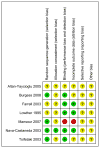Punctal occlusion for dry eye syndrome
- PMID: 20824852
- PMCID: PMC3729223
- DOI: 10.1002/14651858.CD006775.pub2
Punctal occlusion for dry eye syndrome
Update in
-
Punctal occlusion for dry eye syndrome.Cochrane Database Syst Rev. 2017 Jun 26;6(6):CD006775. doi: 10.1002/14651858.CD006775.pub3. Cochrane Database Syst Rev. 2017. PMID: 28649802 Free PMC article.
Abstract
Background: Dry eye syndrome is a disorder of the tear film and is associated with symptoms of ocular discomfort. Punctal occlusion is a mechanical treatment in which the tear drainage system is blocked in order to aid in the preservation of natural tears on the ocular surface.
Objectives: The objective of this review was to assess the safety and efficacy of punctal plugs for the management of dry eye.
Search strategy: We searched the Cochrane Central Register of Controlled Trials (CENTRAL) (which contains the Cochrane Eyes and Vision Group Trials Register) (The Cochrane Library 2010, Issue 6), MEDLINE (January 1950 to June 2010), EMBASE (January 1980 to June 2010), Latin American and Caribbean Literature on Health Sciences (LILACS) (January 1982 to June 2010), the metaRegister of Controlled Trials (mRCT) (www.controlled-trials.com) and ClinicalTrials.gov (http://clinicaltrials.gov). We also searched the Science Citation Index-Expanded database and reference lists of included studies. There were no language or date restrictions in the search for trials. The electronic databases were last searched on 21 June 2010.
Selection criteria: We included randomized and quasi-randomized controlled trials of collagen or silicone punctal plugs in symptomatic participants diagnosed with aqueous tear deficiency or dry eye syndrome.
Data collection and analysis: Two review authors independently assessed trial quality and extracted data. We contacted study investigators for additional information.
Main results: Seven randomized controlled trials including 305 participants (601 eyes) met the inclusion criteria and are summarized in this review. We did not perform meta-analysis due to appreciable variability in interventions and follow-up intervals. Although punctal plugs provided symptomatic improvement and clinical outcomes also improved from baseline measures, few studies demonstrated a benefit of punctal plugs over the comparison intervention. Reported adverse effects included epiphora (overflow of tears), foreign body sensation, eye irritation, and spontaneous plug loss.
Authors' conclusions: This systematic review shows a relative scarcity of controlled clinical trials assessing the efficacy of punctal occlusion therapy in dry eye. Although the evidence is very limited, the data suggest that silicone plugs can provide symptomatic relief in severe dry eye. Moreover, temporary collagen plugs appear similarly effective to silicone plugs on a short-term basis.
Conflict of interest statement
None known.
Figures
References
References to studies
Included studies
-
- Altan-Yaycioglu R, Gencoglu EA, Akova YA, Dursun D, Cengiz F, Akman A. Silicone versus collagen plugs for treating dry eye: results of a prospective randomized trial including lacrimal scintigraphy. American Journal of Ophthalmology. 2005;140(1):88–93. - PubMed
-
- Burgess PI, Koay P, Clark P. SmartPlug versus silicone punctal plug therapy for dry eye: a prospective randomized trial. Cornea. 2008;27(4):391–4. - PubMed
-
- Farrell J, Patel S, Grierson DG, Sturrock RD. A clinical procedure to predict the value of temporary occlusion therapy in keratoconjunctivitis sicca. Ophthalmic & Physiological Optics. 2003;23(1):1–8. - PubMed
-
- Lowther GE, Semes L. Effect of absorbable intracanalicular collagen implants in hydrogel contact lens patients with symptoms of dryness. International Contact Lens Clinic. 1995;22:238–43.
- Lowther GE, Semes L. Effect of intracanalicular collagen implants on drying symptoms and the tear film of hydrogel contact lens patients. American Academy of Optometry; 1991 Dec; Anaheim (CA). 1991. p. Abstract number 75.
-
- Mansour K, Leonhardt CJ, Kalk WW, Bootsma H, Bruin KJ, Blanksma LJ. Lacrimal punctum occlusion in the treatment of severe keratoconjunctivitis Sicca caused by Sjogren syndrome: a uniocular evaluation. Cornea. 2007;26(2):147–50. - PubMed
Excluded studies
-
- Charnetski-Sites C, Bucci FA., Jr Do silicone punctal plugs impact tear lactoferrin levels following LASIK. American Academy of Optometry; 2001 Dec; Philadelphia (PA). 2001. p. Abstract 203.
-
- Geldis JR, Nichols JJ. The impact of punctal occlusion on soft contact lens wearing comfort and the tear film. Eye & Contact Lens. 2008;34(5):261–5. - PubMed
-
- Giovagnoli D, Graham SJ. Inferior punctal occlusion with removable silicone punctal plugs in the treatment of dry-eye related contact lens discomfort. Journal of the American Optometric Association. 1992;63(7):481–5. - PubMed
-
- Goto E, Yagi Y, Kaido M, Matsumoto Y, Konomi K, Tsubota K. Improved functional visual acuity after punctal occlusion in dry eye patients. American Journal of Ophthalmology. 2003;135(5):704–5. - PubMed
-
- Guzey M, Ozardali I, Kilic A, Basar E, Dogan Z, Satici A, et al. The treatment of severe trachomatous dry eye with canalicular silicone plugs. Eye. 2001;15(Pt 3):297–303. - PubMed
Other references
Additional references
-
- American Academy of Ophthalmology (AAO) Cornea/External Disease Panel. [accessed 27 April 2010];Preferred Practice Pattern for Dry Eye Syndrome. 2003 Sep;:1–21. http://one.aao.org/CE/PracticeGuidelines/default.aspx.
-
- Balaram M, Schaumberg DA, Dana MR. Efficacy and tolerability outcomes after punctal occlusion with silicone plugs in dry eye syndrome. American Journal of Ophthalmology. 2001;131(1):30–6. - PubMed
-
- Barnard NA. Punctal and intracanalicular occlusion - a guide for the practitioner. The College of Optometrists. Ophthalmic and Physiological Optics. 1996;16(Suppl 1):S15–22. - PubMed
-
- Dalzell MD. Dry eye: prevalence, utilization, and economic implications. Managed Care. 2003;12(12 Suppl):9–13. - PubMed
-
- De Paiva CS, Chen Z, Koch DD, Hamill MB, Manuel FK, Hassan SS, et al. The incidence and risk factors for developing dry eye after myopic LASIK. American Journal of Ophthalmology. 2006;141(3):438–45. - PubMed
Publication types
MeSH terms
Grants and funding
LinkOut - more resources
Full Text Sources
Other Literature Sources
Miscellaneous


